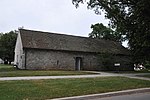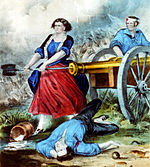The United States Indian Industrial School in Carlisle, Pennsylvania, generally known as Carlisle Indian Industrial School, was the flagship Indian boarding school in the United States from its founding in 1879 through 1918. It took over the historic Carlisle Barracks, which was transferred to the Department of Interior from the War Department. After the United States entry into World War I, the school was closed and this property was transferred back for use by the Department of Defense. All the property is now part of the U.S. Army War College.
Founded in 1879 under U.S. governmental authority by Lieutenant Richard Henry Pratt, Carlisle was an early federally funded off-reservation Indian boarding school initiated by the U.S. government. This was similar to the Choctaw Academy in Scott County, Kentucky, which was the first boarding school, but was initiated by Choctaw leaders and then funded by the U.S. government through the 1819 Civilization Act.Pratt had earlier supervised Native American prisoners of war, and supported some of them in gaining education at Hampton College. He became convinced that education was the key to assimilation. In his own words, Pratt's motto was, "Kill the Indian, save the man." The US applied this principle to the cultural assimilation efforts of the larger American Indian boarding school system, by requiring children to speak only English, practice Christianity, take on new names and wear European-American style clothing.Pratt wrote that he believed that Native Americans were 'equal' to European Americans, and that the school worked to immerse students into mainstream Euro-American culture. He believed that this would enable them to advance and thrive in the dominant society, and be leaders to their people.After the government assessed the initial success of older Indian students at Hampton Normal and Agricultural School and some in upstate New York, who were former prisoners of war, Lieutenant Pratt was authorized to establish the first all-Indian school, Carlisle, in 1879 at the historic Carlisle Barracks in central Pennsylvania. The property was transferred from the War Department to the Department of Interior for this purpose.
As at Hampton, arriving students were shorn of their long hair, and even their names were changed. However, "unlike Hampton, whose purpose was to return assimilated educated Indians to their people, Carlisle meant to turn the school into the ultimate Americanizer". At Carlisle, Pratt established a highly structured, quasi-military regime. He was known to use corporal punishment (which was not uncommon in society at the time) on students who exhibited Native behavior, so that they would rely only on themselves.Carlisle became the model for 26 off-reservation Bureau of Indian Affairs boarding schools in 15 states and territories. Some private boarding schools were sponsored by religious denominations. It has been designated as a National Historic Landmark. In addition, the government operated a total of more than 300 schools on reservations, many of which accepted boarding students from other tribes.
From 1879 until 1918, more than 10,000 Native American children from 140 tribes attended Carlisle. The school's 1911 Annual Report included the results of an employment survey of 532 graduates and 3619 other ex-students. Tribes with the largest number of students included the Lakota, Ojibwe, Cherokee, Apache, Cheyenne, Alaska Native, Iroquois Seneca and Oneida. The Carlisle Indian School exemplified Progressive Era values. Some believed Carlisle provided an excellent education.
Since the late 20th century, there has been re-evalutation of the assimilation policies of the government and practices of Carlisle and similar schools have been the basis of controversy. Many Native Americans have criticized the break-up of their families by years at such boarding schools, as well as the efforts to force children away from their families' cultures. Some have condemned Pratt's views on assimilation.







